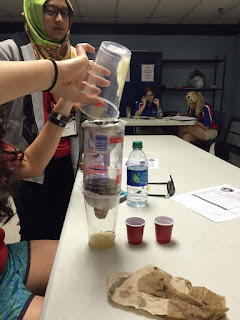It’s hard to think of a time before
space exploration, especially for those of you who are in elementary
school. I bet if you ask your grandparents,
they will have stories about watching some of the first space missions take place,
on TV. It’s pretty amazing
considering the fact that less than 70 years before we put a man on the moon,
humans weren’t even flying yet.
Inception
In
1958, President Eisenhower commissioned the creation of the National
Aeronautics and Space Administration, or NASA. That year, NASA had its first launch and also launched the
first satellite into orbit. The
next year, the first meteorological satellite was launched, helping to predict
the weather all over the world.
Groovy Sixties
In 1961, President John F. Kennedy
officially started the “space race”.
He committed to putting a man on the moon before the year 1970. He made this commitment only 20 days
after the first American was launched into space. During the next few years, NASA continued testing space
travel with Project Mercury. John
Glenn piloted one of the most famous Mercury flights, becoming the first
American to orbit the earth.
Eventually,
Project Mercury was ended and NASA moved to Project Gemini. These flights put humans in orbit for
days at a time. In 1965, Frank Borman and James A. Lovell stayed in orbit for 14 days,
setting a record that would last for five years.
In
1969, space travel really started to get exciting! On July 20, just months before the end of the decade, Apollo
11 landed on the surface of the moon.
Two men, Neil Armstrong and Buzz Aldrin walked on the moon, planted an
American Flag and took samples of moon rocks. During this landing, as he stepped onto the surface of the
moon, Neil Armstrong told the world that it was “one small step for man-one
giant leap for mankind.”
Psychedelic Seventies
1973 brought the launch of Skylab, an
orbiting workshop for space research and technology. This first space station was the precursor to the
International Space Station (ISS), which would be launched and docked for work
in 1999. Currently 15 countries
participate in the ISS project, including the United States, Russia, Japan and
England. (For more info on the ISS, visit https://www.nasa.gov/mission_pages/station/main/index.html)
A photo of the International Space Station.
Tubular Eighties
In the 1970’s and 1980’s the space
program launched many probes, set to explore other planets and outer regions of
space. NASA also tested many types
of shuttles, leading to the familiar design from the most recent shuttle
missions. Additionally, America
sent the first African American, Guion S. Bluford, and the first woman, Sally
Ride, into space.
Guion S. Bluford
Sally Ride
A Tragic Turn of
Events
Although there were many triumphs,
there were also some tragedies.
These included the fire that overtook the astronauts, Virgil “Gus” Grissom, Edward H. White II, and Roger B.
Chaffee while they were rehearsing the launch of Apollo 1.
Space Shuttles Challenger and Colombia exploded while in
flight, killing seven astronauts in each instance. These astronauts included Christa McAuliffe, who is
especially close to my heart, as she was a teacher chosen to be a part of the
Challenger crew. She was born in
Boston and taught in New Hampshire, before perishing, while fulfilling one of
her dreams.
Radical Nineties
The 1990’s held many new
missions. Much work was done on
the ISS during this time. The
Hubble Telescope was also launched.
We are still getting information and images from the Hubble today. It is currently orbiting the Earth at 5
miles per SECOND. At that speed,
you could get from New York to Los Angeles in 10 minutes!
The Hubble Telescope
Mad-Tight Millennium
In the first decade of the new
millennium, NASA stayed the course and continued space explorations, beginning
to focus on Mars and other terrestrial planets. They also continued to expand the use of the ISS. All of these new developments would set
the stage for upcoming missions in a new era of space travel.
Space Shuttle Endeavour- This type of shuttle has been retired, making way for a new design as we go to Mars
Next
week, we’ll discover the current missions of NASA, including some that are
going on RIGHT NOW in space! Be sure to visit the NASA 50th Anniversary Timeline (Linked on the right), it's actually reallllyyyy interesting and interactive! Until
then, keep your eyes on the sky.
T-minus 20 days until Space Camp!


































